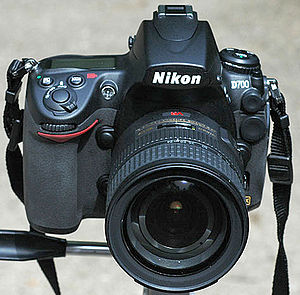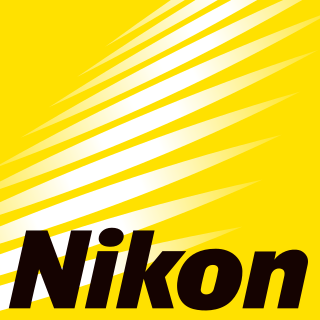
Nikon Corporation, also known just as Nikon, is a Japanese multinational corporation headquartered in Tokyo, Japan; it specializes in creating and marketing optics and imaging products. The companies held by Nikon form the Nikon Group.
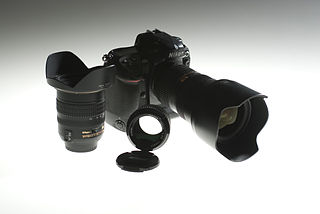
The Nikon D2X is a 12.4-megapixel professional digital single-lens reflex camera (DSLR) that Nikon Corporation announced on September 16, 2004. The D2X was the high-resolution flagship in Nikon's DSLR line until June 2006 when it was supplanted by the D2Xs and, in time, the Nikon D3 range, Nikon D4 range, the Nikon D5 and the Nikon D6— the latter four using a FX full-format sensor.
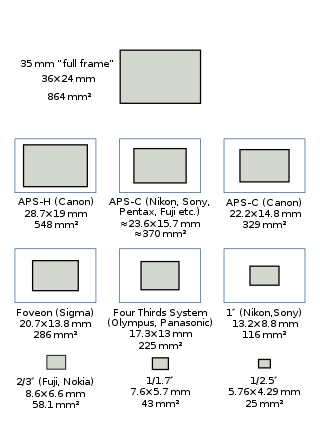
A full-frame DSLR is a digital single-lens reflex camera (DSLR) with a 35 mm image sensor format. Historically, 35 mm was one of the standard film formats, alongside larger ones, such as medium format and large format. The full-frame DSLR is in contrast to full-frame mirrorless interchangeable-lens cameras, and DSLR and mirrorless cameras with smaller sensors, much smaller than a full 35 mm frame. Many digital cameras, both compact and SLR models, use a smaller-than-35 mm frame as it is easier and cheaper to manufacture imaging sensors at a smaller size. Historically, the earliest digital SLR models, such as the Nikon NASA F4 or Kodak DCS 100, also used a smaller sensor.

The Nikon D200 is a 10.2-megapixel digital single-lens reflex camera that falls between entry-level/midrange DSLR cameras such as the Nikon D40, Nikon D40x, and D80 and high-end models such as the Nikon D2Hs and D2Xs. It was released by the Nikon Corporation in November 2005. The D200 was succeeded by the D300 in August 2007.

The Nikon D3 is a 12.0-megapixel professional-grade full frame (35 mm) digital single lens reflex camera (DSLR) announced by the Nikon Corporation on 23 August 2007 along with the Nikon D300 DX format camera. It was Nikon's first full-frame DSLR. The D3, along with the Nikon D3X, was a flagship model in Nikon's line of DSLRs, superseding the D2Hs and D2Xs. It was replaced by the D3S as Nikon's flagship DSLR. The D3, D3X, D3S, D4, D4s, D5, D6, D700, D800, D800Е and Df are the only Nikon FX format DSLRs manufactured in Japan. The D3S was replaced by the D4 in 2012.

The Nikon D300 is a 12.3-megapixel semi-professional DX format digital single-lens reflex camera that Nikon Corporation announced on 23 August 2007 along with the Nikon D3 FX format camera. The D300 was discontinued by Nikon on September 11, 2009, being replaced by the modified Nikon D300S, which was released July 30, 2009. The D300S remained the premier Nikon DX camera until the D7100 was released in early 2013.

The Nikon D60 is a 10.2-megapixel Nikon F-mount digital single-lens reflex camera announced in January 2008. The D60 succeeds the entry-level Nikon D40x. It features the Nikon EXPEED image processor introduced in the higher-end Nikon D3 and D300.
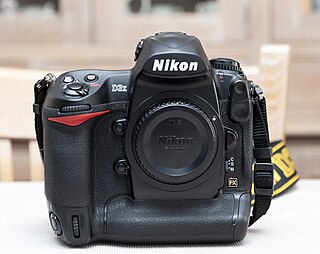
The Nikon D3X is a 24.4-megapixel professional-grade full-frame digital single-lens reflex camera (DSLR) announced by the Nikon Corporation on 1 December 2008. The D3X is the third camera in Nikon's line to offer a full-frame sensor, following the D3 and D700. As Nikon's new flagship model, it augments the Nikon D3S, Nikon's high-speed professional model, and while the D3S retains advantages in terms of high ISO performance and higher frame rate, the D3X offers a dramatic increase in resolution and image detail.

The Nikon AF-S DX Nikkor 35mm f/1.8G is a lens manufactured by Nikon for use on Nikon DX format digital SLR cameras. It provides a field of view on a DX format camera similar to that of a normal lens on a 35mm film format camera.

The D5000 is a 12.3-megapixel DX-format DSLR Nikon F-mount camera, announced by Nikon on 14 April 2009. The D5000 has many features in common with the D90. It features a 2.7-inch 230,000-dot resolution tilt-and-swivel LCD monitor, live view, ISO 200–3200, 3D tracking Multi-CAM1000 11-point AF system, active D-Lighting system and automatic correction of lateral chromatic aberration. The D5000 seems to have been discontinued in November 2010.

The Nikon D3000 is a 10.2-megapixel DX format DSLR Nikon F-mount camera announced by Nikon on 30 July 2009. It replaces the D40 as Nikon's entry level DSLR. It features a 3.0-inch 230,000-dot resolution LCD monitor, CCD sensor with ISO 100–1600 and 3D tracking Multi-CAM1000 11-point AF system which makes it quite similar to the Nikon D200 in these main parts. Initially priced with $599 MSRP, actual prices are much lower.

The Nikon D300S is a 12.3-megapixel DX format digital single-lens reflex camera (DSLR) announced by Nikon on 30 July 2009. It replaced the D300 as Nikon's flagship DX format DSLR adding HD video recording. It has some similarities to the Nikon D700, with the same resolution, but has a smaller, higher-density sensor. The D300s was superseded by the Nikon D500, announced on January 5, 2016.

The Nikon D3S is a 12.1-megapixel professional-grade full frame (35mm) digital single-lens reflex camera (DSLR) announced by Nikon Corporation on 14 October 2009. The D3S is the fourth camera in Nikon's line to feature a full-frame sensor, following the D3, D700 and D3X. It is also Nikon's first full-frame camera to feature HD (720p/30) video recording. While it retains the same number of pixels as its predecessor, the imaging sensor has been completely redesigned. Nikon claims improved ultra-high image sensor sensitivity with up to ISO 102400, HD movie capability for extremely low-lit situations, image sensor cleaning, optimized workflow speed, improved autofocus and metering, enhanced built-in RAW processor, quiet shutter-release mode, up to 4,200 frames per battery charge and other changes compared with the D3. It was replaced by the D4 as Nikon's high speed flagship DSLR.

The Nikon D7000 is a 16.2-megapixel digital single-lens reflex camera (DSLR) model announced by Nikon on September 15, 2010. It replaced the D90 as the top end consumer camera, by using much of the technology and controls from the earlier D5000, in a larger more robust body similar to the flagship D300 series. In some ways it was superior to the D300S, though for several years the two cameras were both available with the D300 positioned as the flagship in Nikon marketing materials.

The Nikon D5100 is a 16.2-megapixel DX-format DSLR F-mount camera announced by Nikon on April 5, 2011. It features the same 16.2-megapixel CMOS sensor as the D7000 with 14-bit depth, while delivering Full HD 1080p video mode at either 24, 25 or 30fps. The D5100 is the first Nikon DSLR to offer 1080p video at a choice of frame rates; previous Nikon DSLRs that recorded 1080p only did so at 24 fps. It replaced the D5000 and was replaced by the D5200.

The Nikon Expeed image/video processors are media processors for Nikon's digital cameras. They perform a large number of tasks: Bayer filtering, demosaicing, image sensor corrections/dark-frame subtraction, image noise reduction, image sharpening, image scaling, gamma correction, image enhancement/Active D-Lighting, colorspace conversion, chroma subsampling, framerate conversion, lens distortion/chromatic aberration correction, image compression/JPEG encoding, video compression, display/video interface driving, digital image editing, face detection, audio processing/compression/encoding and computer data storage/data transmission.

The Nikon D3200 is a 24.2-megapixel DX format DSLR Nikon F-mount camera officially launched by Nikon on April 19, 2012. It is marketed as an entry-level DSLR camera for beginners and experienced DSLR hobbyists who are ready for more advanced specs and performance.
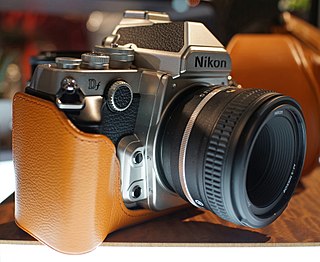
The Nikon Df is a full-frame F-mount DSLR FX format camera announced by Nikon on November 5, 2013. It uses dedicated mechanical controls similar to those used on mechanical 35mm film SLR camera and had an appearance similar to the Nikon FE and Nikon FM film cameras. Nikon's website stated "Using its large, metallic mechanical dials, photographers will rediscover a more direct connection with their camera."

The Nikon D750 is a full-frame DSLR camera announced by Nikon on September 12, 2014. It is an extensive upgrade from the D610, but with the same general body and control characteristics, along with 24 megapixel resolution. Despite the 7, there is little relationship with the D700, which was the precursor to the D800. The D600 and D610 evolved as a full-frame consumer cameras with similar structure and controls to the D7000 series of cropped frame cameras. The D750 shares similar structure and controls with the cropped-frame D7500.
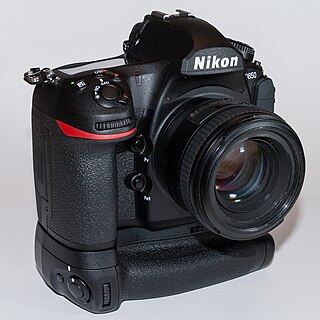
The Nikon D850 is a professional-grade full-frame digital single-lens reflex camera (DSLR) produced by Nikon. The camera was officially announced on July 25, 2017, launched on August 24, 2017, and first shipped on September 8, 2017. Nikon announced it could not fill the preorders on August 28, 2017 and filled less than 10% of preorders on the first shipping day. It is the successor to the Nikon D810.
